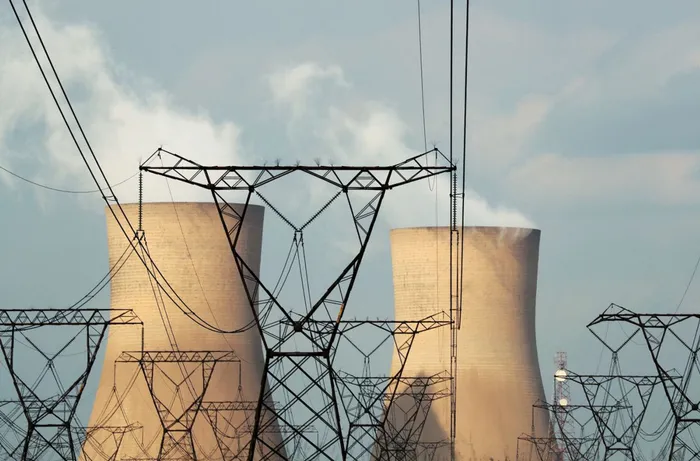Eskom welcomes IRP 2025 as roadmap for South Africa’s energy transition

Eskom on Monday said the IRP 2025 provides a clear and practical investment framework for ensuring reliable electricity supply to support inclusive economic growth—particularly at a time when overall unemployment remains around 30% and youth unemployment exceeds 50%.
Image: Mike Hutchings/Reuters
Eskom has welcomed the release of the Integrated Resource Plan (IRP) 2025, describing it as a critical roadmap for balancing energy security, affordability, environmental sustainability, and socio-economic development as South Africa advances its transition from high-carbon to low-carbon energy sources.
This comes after Minister of Electricity and Energy, Dr Kgosientsho Ramokgopa, on Sunday announced that the newly unveiled the IRP 2025 will unlock R2.2 trillion in investment over the next 15 years — a programme he described as the largest infrastructure build initiative in South Africa’s democratic history.
Ramokgopa said the investment would be an off-balance sheet intervention, largely funded by the private sector through opportunities outlined in the IRP, which seeks to shift the country’s energy mix toward cleaner sources.
The IRP outlines the addition of 11 270 megawatts (MW) of solar photovoltaic (PV) capacity by 2030, 7 340 MW of wind energy, and a 6 000 MW gas-to-power programme. There are currently no immediate plans for green hydrogen projects.
Eskom on Monday said the IRP 2025 provides a clear and practical investment framework for ensuring reliable electricity supply to support inclusive economic growth—particularly at a time when overall unemployment remains around 30% and youth unemployment exceeds 50%.
The utility confirmed it will conduct a detailed review of the plan and publish a comprehensive response alongside an updated strategic plan in the coming weeks.
Eskom CEO Dan Marokane said the IRP 2025 is not merely a policy update it is a clear investment roadmap, informed by the input of over 4000 interested parties at the public consultation stage.
"It signals to investors, regulators, and our citizens that South Africa has a focussed pathway to reach NetZero inclusively and provides the opportunity for Eskom to play its role fairly and compete in a reformed electricity supply industry," Marokane said.
"The IRP 2025 requires significant investment to be attracted quickly, that will only come from rules-based regulatory reform anchored in law to enable investors to deploy capital in South Africa with confidence and certainty."
Marokane added that Eskom is well positioned to contribute meaningfully to the plan’s implementation through its ongoing turnaround strategy.
“We have been preparing to accelerate the delivery of Eskom’s contribution to the IRP 2025 through the implementation of our turnaround strategy. With load shedding largely behind us the country again has a continuous 24/7 electricity supply—commonly referred to as baseload capacity, that forms the backbone for renewable energy growth," he said.
"Renewables are variable in nature and need reliable, continuous baseload to maintain grid stability and supply. Our return to profitably for the first time in eight years reflects long-term structural operational improvements and combined with our skilled workforce will lead to increasing investor confidence to deliver the IRP 2025 with partners,” Marokane continued.
However, The Green Connection said it is concerned with this approach to the energy mix, arguing that a credible phase-out of fossil fuels must be clearly reflected in the plan, meaning no new investments in oil, gas and coal.
Liz McDaid, strategic lead at The Green Connection, said Monday that though Ramokgopa introduced the country’s electricity plan, the full document was not made available and it appears the gazetted version will only be released at the end of the week.
“Although the inclusion of more renewable energy and storage is positive, it is worrying that no clear price path was presented," McDaid said.
"For years, government has announced large-scale energy infrastructure projects without sufficient clarity on who will ultimately bear the cost. As electricity consumers, we should all be very concerned about the implications of this plan."
The Green Connection’s community outreach co-ordinator, Neville van Rooy, said while the IRP claims to focus on emission reductions and affordability, it seems to include significant allocations to gas-to-power and nuclear – both of which raise major concerns.
"Gas is harmful to the climate (it releases methane, which is up to 80 times more potent than CO₂ in terms of short‐term warming), and new nuclear could make electricity prohibitively expensive for South African consumers,” Van Rooy said.
Currently, South Africa’s generation mix comprises 58% coal, 10% rooftop solar PV, another 10% grid-connected solar PV, 8% wind, 4.5% diesel, 4% pumped storage, and 3% nuclear.
BUSINESS REPORT